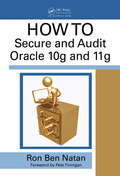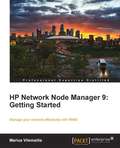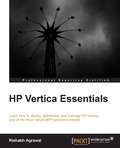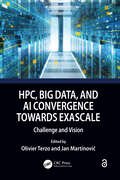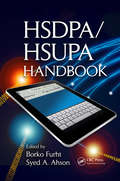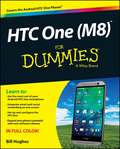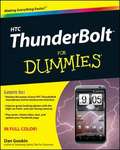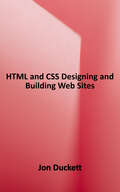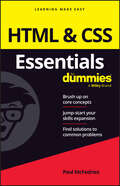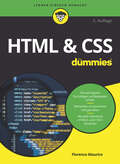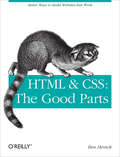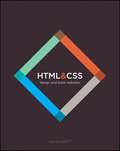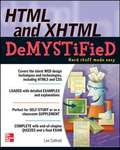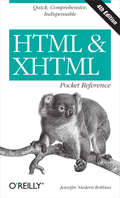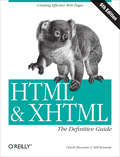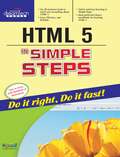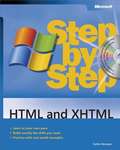- Table View
- List View
HOWTO Secure and Audit Oracle 10g and 11g
by Ron Ben-NatanThis guide demonstrates how to secure sensitive data and comply with internal and external audit regulations using Oracle 10g and 11g. It provides the hands-on guidance required to understand the complex options provided by Oracle and the know-how to choose the best option for a particular case. The book presents specific sequences of actions that should be taken to enable, configure, or administer security-related features. It includes best practices in securing Oracle and on Oracle security options and products. By providing specific instructions and examples this book bridges the gap between the individuals who install and configure a security feature and those who secure and audit it.
HP Network Node Manager 9: Getting Started
by Marius VilemaitisThis book is a step-by-step guide describing how to implement, maintain, and expand the NNMi management tool. It is a practical guide, based on experience managing networks in a wide scale of network operation centers. It shares best practices and explains a lot of non-technical issues that arise during implementations and operations. Each topic has practical examples where the reader can practice while reading the book.The book is written for the following audience:Monitoring solution designers, who plan how to implement NNMi Network engineers, who plan to start managing their network System administrators, who start administering NNMi Network monitoring operators, who want to learn how to use NNMi If you belong to any one of the above professions, then this book is for you. It's also for professionals who describe themselves as beginners, or intermediate-level professionals. The book is also suitable for old-version NNM users who wish to switch to NNMi.
HP Vertica Essentials
by Rishabh AgrawalThis is a step-by-step guide with an easy-to-follow approach. A variety of diagrams and images support the concepts explored in the book. This book also contains important tips and tricks, thus making it a really useful reference for Vertica administration activities. If you are a Vertica user or DBA who wants to perform basic administration and fi ne tuning, then this book is for you. Prior knowledge of Vertica will help you to understand the concepts better, but is not mandatory. Some intermediate knowledge of RDBMS, SQL, Linux, and scripting languages such as Perl or Python will be helpful.
HPC, Big Data, and AI Convergence Towards Exascale: Challenge and Vision
by Olivier TerzoHPC, Big Data, AI Convergence Towards Exascale provides an updated vision on the most advanced computing, storage, and interconnection technologies, that are at basis of convergence among the HPC, Cloud, Big Data, and artificial intelligence (AI) domains. Through the presentation of the solutions devised within recently founded H2020 European projects, this book provides an insight on challenges faced by integrating such technologies and in achieving performance and energy efficiency targets towards the exascale level. Emphasis is given to innovative ways of provisioning and managing resources, as well as monitoring their usage. Industrial and scientific use cases give to the reader practical examples of the needs for a cross-domain convergence. All the chapters in this book pave the road to new generation of technologies, support their development and, in addition, verify them on real-world problems. The readers will find this book useful because it provides an overview of currently available technologies that fit with the concept of unified Cloud-HPC-Big Data-AI applications and presents examples of their actual use in scientific and industrial applications.
HPC@Green IT
by Ralf Gruber Vincent Keller Erich StrohmaierThe authors present methods to reduce computer energy consumption by means of a better usage of a specific set of resources and maximizing the efficiency of the running applications. The processor frequency is adjusted to the needs of the running job, leading to a power drop by a factor of 2 and doubling battery life time of laptops. It is shown how computer resources can be optimally adapted to application needs, reducing job run time. Examples on how to optimize algorithms on single node and parallel RISC architectures are discussed. The job-related data are stored and reused to help computer managers to replace machines.
HSDPA/HSUPA Handbook
by Borko Furht Syed A. AhsonHigh Speed Packet Access (HSPA) is a collection of two mobile telephony protocols, High Speed Downlink Packet Access (HSDPA) and High Speed Uplink Packet Access (HSUPA). Allowing networks based on the Universal Mobile Telecommunications System to achieve data rates of several megabits per second, these powerful protocols are ideal for applications
HTC One (M8) For Dummies
by Bill HughesGet the most out of your HTC One (M8) smartphoneHTC One (M8) For Dummies is a practical user's guide to the HTC One (M8) device, covering a range of pragmatic and how-to topics, from the most useful features and tricks of the core applications to techniques to get the most out of your smartphone. Approaching the capabilities of the HTC One (M8) from the point of view of a user who is intimidated by the technology, and perhaps a bit baffled by the documentation and online support that come with the phone, this handy guide covers all aspects of the HTC One (M8) in a familiar and friendly tone.Inside, you'll find trusted and easy-to-follow guidance on everything needed to optimize your experience with your new HTC One (M8) device: setting-up and configuring your phone; staying in touch with texting, e-mailing, and social networking; surfing the web; getting around with maps and navigation; capturing memories with photos and videos; kicking back with movies; loading up on apps; synching with a PC; and so much more.Clearly explains how to integrate e-mail and social networking on one screenDemonstrates why the HTC One (M8) is getting rave reviews, thanks to its amazing camera and video capabilities, battery life, form and function, and overall fantastic benchmarksShows you how to set up and configure the HTC One (M8)Walks you through expanding your phone's potential with new software releasesDon't let the intimidation of technology get the best of you--let HTC One (M8) For Dummies maximize the performance of your awesome new smartphone.
HTC ThunderBolt For Dummies
by Dan GookinFull-color guide to the exciting HTC Droid ThunderBolt! Now that you've got your high-powered new HTC ThunderBolt smartphone, you've got to figure out how to use it! If you're more than a little intimidated by the technology and somewhat put off by the formal documentation, this book can help. Written in the fun but clear and thorough For Dummies style, this book answers all your questions about Verizon's first 4G LTE Android device and helps you get the very most out of it. Helps you get up to speed quickly on how to use the ThunderBolt smartphone Delves into the basics?how the technology works, how to configure everything, and how to purchase apps through the Android Market or Verizon's AppSphere Delivers a full slate of how-tos, tricks, features, and techniques, all in full color Covers everything you need to know, including setup and configuration, texting, e-mailing, accessing the Internet, maps, navigation, camera, video, and synching with a PC Shows you how to customize your HTC ThunderBolt, how to maintain it, and how to expand or upgrade it with new software Once you learn all the bells and whistles, you'll be overjoyed with your new Android device. The fun starts with HTC ThunderBolt For Dummies.
HTML & CSS Design and Build Websites
by Jon DuckettA two-book set for web designers and front-end developers This two-book set combines the titles HTML & CSS: Designing and Building Web Sites and JavaScript & jQuery: Interactive Front-End Development. Together these two books form an ideal platform for anyone who wants to master HTML and CSS before stepping up to JavaScript and jQuery. HTML & CSS covers structure, text, links, images, tables, forms, useful options, adding style with CSS, fonts, colors, thinking in boxes, styling lists and tables, layouts, grids, and even SEO, Google analytics, FTP, and HTML5. JavaScript & jQuery offers an excellent combined introduction to these two technologies using a clear and simple visual approach using diagrams, infographics, and photographs. - A handy two-book set that uniquely combines related technologies - Highly visual format and accessible language makes these books highly effective learning tools - Perfect for beginning web designers and front-end developers
HTML & CSS Essentials For Dummies
by Paul McFedriesThe easy way to brush up on your HTML & CSS programming skills HTML & CSS Essentials For Dummies is your quick and handy reference to all the core concepts of HTML & CSS—the must-know markup and style languages that make the internet go. This no-nonsense book gets right to the point, eliminating review material, wordy explanations, and fluff. Understand all the fundamentals of HTML and CSS, quickly. Perfect for a brush-up on the basics or as an everyday desk reference on the job, this is the reliable little book you can always turn to for answers. Get simple explanations of the basic concepts of coding with HTML & CSS Review what you've already learned or pick up essential new skills Create attractive and functional front ends for websites of all kinds Keep this concise reference book handy for jogging your memory as you work This book is clear and direct, focusing on the key topics you need to know about defining a website's user interface. Great for supplementing classroom learning, reviewing for a certification, or staying knowledgeable on the job.
HTML & CSS für Dummies (Für Dummies)
by Florence MauriceAuch heute noch sind HTML und CSS die Basis aller Webseiten. Wer mehr möchte, als nur einen unflexiblen Website-Baukasten zu nutzen, kommt an beidem schwer vorbei. Egal, ob Sie eine Website komplett neu aufbauen oder ob Sie beim Einsatz eines Content-Management-Systems individuelle Anpassungen vornehmen möchten: Dieses Buch hilft Ihnen weiter. Florence Maurice erklärt Ihnen mit vielen Beispielen und Schritt für Schritt alle wichtigen Grundlagen, wie HTML funktioniert, wofür Sie CSS benötigen und wie Sie am Ende all dieses Wissen anwenden.
HTML & CSS: Better Ways to Build Websites That Work (Animal Guide)
by Ben HenickHTML and CSS are the workhorses of web design, and using them together to build consistent, reliable web pages requires both skill and knowledge. The task is more difficult if you're relying on outdated, confusing, and unnecessary HTML hacks and workarounds. Author Ben Henick shows you how to avoid those traps by going beyond the standard tips, tricks, and techniques to connect the underlying theory and design of HTML and CSS to your everyday work habits.With this practical book, you'll learn how to work with these tools far more effectively than is standard practice for most web developers. Whether you handcraft individual pages or build templates, HTML & CSS: The Good Parts will help you get the most out of these tools in all aspects of web page design-from layout to typography and to color.Structure HTML markup to maximize the power of CSSImplement complex multi-column layouts from scratchImprove site production values with advanced CSS techniquesSupport formal usability and accessibility requirements with tools built into HTML and CSSAvoid the most annoying browser and platform limitations
HTML & CSS: Design And Build Websites
by Jon DuckettA full-color introduction to the basics of HTML and CSS from the publishers of Wrox! Every day, more and more people want to learn some HTML and CSS. Joining the professional web designers and programmers are new audiences who need to know a little bit of code at work (update a content management system or e-commerce store) and those who want to make their personal blogs more attractive. Many books teaching HTML and CSS are dry and only written for those who want to become programmers, which is why this book takes an entirely new approach. Introduces HTML and CSS in a way that makes them accessible to everyone―hobbyists, students, and professionals―and it’s full-color throughout Utilizes information graphics and lifestyle photography to explain the topics in a simple way that is engaging Boasts a unique structure that allows you to progress through the chapters from beginning to end or just dip into topics of particular interest at your leisure This educational book is one that you will enjoy picking up, reading, then referring back to. It will make you wish other technical topics were presented in such a simple, attractive and engaging way!
HTML & XHTML Demystified
by Lee CottrellHard stuff made easy! Your practical, self-paced guide to HTML and XHTML HTML and XHTML Demystified is a hands-on tutorial that gives you thorough guidance on required Web design techniques and technologies. The book also functions as a useful supplement for textbooks and classroom activities by focusing on the essentials and the most useful tags and properties, while avoiding unnecessary details. Learn to create Web pages, add graphics and links, create tables and frames, integrate forms, and more. Each chapter features valid HTML that follows all of the rules set by the W3C and incorporates the latest standards for HTML5. Web designers need to write pages that are accessible to all users, so each chapter is coded to address the accessibility requirements from the Americans with Disabilities Act and to allow the use of non-English characters. HTML and XHTML Demystified Covers HTML, XHTML, HTML5, and CSS Develops two stand-alone examples per chapter: one created by the author; the other for you to practice Helps you recognize and resolve common HTML errors Includes end-of-chapter quizzes and a final exam to reinforce learning Step-by-step coverage: HTML and The Web; Your First Web Pages; Inserting Graphics; Creating Hyperlinks; Using Lists; Building Tables; Gathering Data with Forms; Page Layout; Scripting; DHTML; Effectively Using Multimedia; Using Frames; Creating a Web Site
HTML & XHTML Pocket Reference: Quick, Comprehensive, Indispensible (Pocket Reference (o'reilly) Ser.)
by Jennifer Niederst RobbinsAfter years of using spacer GIFs, layers of nested tables, and other improvised solutions for building your web sites, getting used to the more stringent standards-compliant design can be intimidating. HTML and XHTML Pocket Reference is the perfect little book when you need answers immediately. Jennifer Niederst-Robbins, author Web Design in a Nutshell, has revised and updated the fourth edition of this pocket guide by taking the top 20% of vital reference information from her Nutshell book, augmenting it judiciously, cross-referencing everything, and organizing it according to the most common needs of web developers. The result is a handy book that offers the bare essentials on web standards in a small, concise format that you can use carry anywhere for quick reference. HTML and XHTML Pocket Reference features easy-to-find listings of every HTML and XHTML tag, and every Cascading Style Sheet value. It's an indispensable reference for any serious web designer, author, or programmer who needs a fast on-the-job resource when working with established web standards.
HTML & XHTML: The Definitive Guide
by Bill Kennedy Chuck Musciano"...lucid, in-depth descriptions of the behavior of every HTML tag on every major browser and platform, plus enough dry humor to make the book a pleasure to read."--Edward Mendelson, PC Magazine"When they say 'definitive' they're not kidding."--Linda Roeder, About.comPut everthing you need to know about HTML & XHTML at your fingertips. For nearly a decade, hundreds of thousands of web developers have turned to HTML & XHTML: The Definitive Guide to master standards-based web development. Truly a definitive guide, the book combines a unique balance of tutorial material with a comprehensive reference that even the most experienced web professionals keep close at hand. From basic syntax and semantics to guidelines aimed at helping you develop your own distinctive style, this classic is all you need to become fluent in the language of web design.The new sixth edition guides you through every element of HTML and XHTML in detail, explaining how each element works and how it interacts with other elements. You'll also find detailed discussions of CSS (Cascading Style Sheets), which is intricately related to web page development. The most all-inclusive, up-to-date book on these languages available, this edition covers HTML 4.01, XHTML 1.0, and CSS2, with a preview of the upcoming XHTML2 and CSS3. Other topics include the newer initiatives in XHTML (XForms, XFrames, and modularization) and the essentials of XML for advanced readers. You'll learn how to:Use style sheets to control your document's appearanceWork with programmatically generated HTMLCreate tables, both simple and complexUse frames to coordinate sets of documentsDesign and build interactive forms and dynamic documentsInsert images, sound files, video, Java applets, and JavaScript programsCreate documents that look good on a variety of browsersThe authors apply a natural learning approach that uses straightforward language and plenty of examples. Throughout the book, they offer suggestions for style and composition to help you decide how to best use HTML and XHTML to accomplish a variety of tasks. You'll learn what works and what doesn't, and what makes sense to those who view your web pages and what might be confusing. Written for anyone who wants to learn the language of the Web--from casual users to the full-time design professionals--this is the single most important book on HTML and XHTML you can own.Bill Kennedy is chief technical officer of MobileRobots, Inc. When not hacking new HTML pages or writing about them, "Dr. Bill" (Ph.D. in biophysics from Loyola University of Chicago) is out promoting the company's line of mobile, autonomous robots that can be used for artificial intelligence, fuzzy logic research, and education.Chuck Musciano began his career as a compiler writer and crafter of tools at Harris Corporations' Advanced Technology Group and is now a manager of Unix Systems in Harris' Corporate Data Center.
HTML & XHTML: The Definitive Guide
by Bill Kennedy Chuck MuscianoHTML and its XML-based descendant, XHTML, are the fundamental languages for working on the web, and the new edition of our popular HTML guide offers web developers a better way to become fluent in these languages. HTML & XHTML: The Definitive Guide, 5th Edition is the most comprehensive, up-to-date book available on HTML and XHTML. It covers Netscape Navigator 6, Internet Explorer 6, HTML 4.01, XHTML 1.0, CSS2, and all of the features supported by the popular web browsers.Learning HTML and XHTML is like learning any new language. Most students first immerse themselves in examples. Studying others is a natural way to learn; however, it's as easy to learn bad habits through imitation as it is to acquire good ones. The better way to become HTML-fluent is through a comprehensive reference that covers the language syntax, semantics, and variations in detail and demonstrates the difference between good and bad usage.In HTML & XHTML: The Definitive Guide, the authors cover every element of HTML/XHTML in detail, explaining how each element works and how it interacts with other elements. Tips about HTML/XHTML style help you write documents ranging from simple online documentation to complex presentations. With hundreds of examples, the book gives you models for writing your own effective web pages and for mastering advanced features like style sheets and frames.HTML & XHTML: The Definitive Guide, 5th Edition, shows how to:Use style sheets to control a document's appearanceWork with programmatically generated HTMLCreate tables, from simple to complexUse frames to coordinate sets of documentsDesign and build interactive forms and dynamic documentsInsert images, sound files, video, Java applets, and JavaScript programsCreate documents that look good on a variety of browsersMake the transition to XHTMLThe book comes with a handy quick-reference card listing HTML/XHTML tags.
HTML 5
by Preston Prescott Eleonora BaronScoprite le novità di HTML Grazie a questo libro scoprirete le basi di HTML 5 e come utilizzarlo. Se conoscete già le precedenti versioni di HTML, in special modo HTML 4, imparare a usare HTML 5 sarà un gioco da ragazzi. HTML 5 è la versione più recente dell' Hypertext Markup Language, tuttavia ha mantenuto svariate caratteristiche di HTML 4 e persino di XHTML. Cosa scoprirete leggendo questo volume? *Le differenze tra HTML 4 e 5 *La struttura dei documenti HTML 5 *Come gestire titoli, paragrafi, elenchi, tabelle e form *Come gestire i link e le immagini *Come incorporare contenuti complessi, citazioni, video e audio *Come formattare le vostre pagine web nel modo più accattivante ed efficace Volete saperne di più? Scaricate subito la vostra copia!
HTML 5
by Preston Prescott Paulo Alexandre F. M. TorresDescubra o que há de novo em HTML 5 Neste livro, irá descobrir o básico do HTML 5 e como funciona. Se já estiver familiarizado com outras versões do HTML, especialmente o HTML 4, então aprender HTML 5 será muito fácil para si. O HTML 5 é a última versão da Linguagem Markup de Hipertexto, no entanto incorpora várias caraterísticas do HTML 4 e mesmo do XHTML.
HTML 5
by Preston Prescott Álvaro Gutiérrez SánchezEn este libro, vas a descubrir los fundamentos de HTML 5, así como su funcionamiento. Descubre las novedades de HTML 5 En este libro, vamos a aprender los conceptos básicos de HTML 5, que es un lenguaje de marcado, así como su funcionamiento. Si ya has trabajado con otras versiones de HTML, y especialmente si lo has hecho con HTML 4, entonces dominar HTML 5 te resultará pan comido. HTML 5 es la última versión del Lenguaje de Marcado de Hipertexto (HTML, del inglés Hypertext Markup Language), e incorpora varias características que ya estaban presentes en HTML 4 e incluso en XHTML (la tercera versión). Qué vas a aprender con este libro: Las diferencias entre HTML 4 y HTML 5 Cómo es la estructura de un documento HTML 5 Párrafos y encabezados en HTML 5 Cómo dar formato al texto y crear listas en HTML 5 Cómo crear tablas de contenido en HTML 5 Cómo insertar formularios en HTML 5 Cómo añadir hipervínculos en HTML 5 Cómo añadir imágenes Cómo añadir videos y audio Estructura interna de una página web Cómo trabajar con elementos de cita, iframe, y caracteres especiales Y mucho más ¿Quieres aprender todo esto? Date prisa...Puedes descargar tu copia de "HTML 5" con un precio especial de $2,99, solo por tiempo limitado. ¡Descarga ahora tu copia! Sube al inicio de la página y haz clic en el botón de Comprar
HTML Pocket Reference, 2nd Edition
by Jennifer NiederstAn indispensable reference for web designers, authors and programmers, this concise guide to every HTML tag has been brought up-to-date with the current HTML specification (4.01). Each tag entry includes detailed information on the tag's attributes and support information for the latest web browsers -- Netscape 6, IE 6, and Opera 5. Author Jennifer Niederst provides context for the tags, indicating which are grouped together, and offers bare-bones examples of how standard web page elements are constructed.
HTML Utopia: Designing Without Tables Using CSS
by Dan ShaferThis book is for Web Developers who want to develop or migrate existing websites from using table-based layouts to using Cascading Style Sheets, which allows for faster page downloads, easier maintainence, faster Website re-designs and better search engine optimization. HTML Utopia covers all aspects of using Cascading Style Sheets in Web Development, and is a must-read for Web Developers designing new sites or upgrading existing ones to use CSS layouts. This book includes one of the most comprehensive CSS2 references on the market. Jeffrey Zeldman, web design guru and co-founder of the Web Standards Project says about this book "After reading this book, you will not only understand how to use CSS to emulate old-school, table driven web layouts, you will be creating Web sites that would be impossible to design using traditional methods".
HTML and XHTML Pocket Reference
by Jennifer Niederst RobbinsAfter years of using spacer GIFs, layers of nested tables, and other improvised solutions for building your web sites, getting used to the more stringent "standards-compliant" design that is de rigueur among professionals today can be intimidating.With standards-driven design, keeping style separate from content is not just a possibility but a reality. You no longer use HTML and XHTML as design tools, but strictly as ways to define the meaning and structure of web content. And Cascading Style Sheets (CSS) are no longer just something interesting to tinker with, but a reliable method for handling all matters of presentation, from fonts and colors to page layout. When you follow the standards, both the site's design and underlying code are much cleaner. But how do you keep all those HTML and XHTML tags and CSS values straight? Jennifer Niederst-Robbins, the author of our definitive guide on standards-compliant design, Web Design in a Nutshell, offers you the perfect little guide when you need answers immediately: HTML and XHTML Pocket Reference. This revised and updated new edition takes the top 20% of vital reference information from her Nutshell book, augments it judiciously, cross-references everything, and organizes it according to the most common needs of web developers. The result is a handy book that offers the bare essentials on web standards in a small, concise format that you can use carry anywhere for quick reference. This guide will literally fit into your back pocket.Inside HTML and XHTML Pocket Reference, you'll find instantly accessible alphabetical listings of every element and attribute in the HTML 4.01 and XHTML 1.0 Recommendations. This is an indispensable reference for any serious web designer, author, or programmer who needs a fast on-the-job resource when working with established web standards.
HTML and XHTML Step by Step
by Faithe WempenExperience learning made easy?and quickly teach yourself the skills you need to create Web pages with HTML and XHTML. With STEP BY STEP, you can take just the lessons you need, or work from cover to cover. Either way, you drive the instruction?building and practicing the skills you need, just when you need them!Structure your page with tables, frames, or a division-based layout Create bulleted and numbered lists for easy-to-read text Include hyperlinks and menu bars for clear navigation Add graphics, sounds, and videos to your pages Apply colors, font sizes, and other formatting with tags or Cascading Style Sheets Build user-input forms with option buttons, check boxes, and drop-down menus Includes coverage of Microsoft Office Word 2003 and FrontPage 2003 Practice files, eBooks, and other resources on the CD! Your Microsoft Office System Reference Pack on CD includes: HTML color reference charts HTML and XHTML templates Bonus guides: "Designing for Accessibility" and "Designing for Usability" Microsoft Office System Quick Reference eBook Insider's Guide to Microsoft Office OneNote 2003 eBook Microsoft Computer Dictionary, Fifth Edition, eBook?10,000+ entries! Introducing the Tablet PC eBook Complete STEP BY STEP eBook Skill-building practice files
